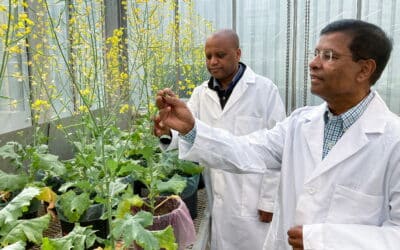When the Alberta government released its provincial budget in March, it was met with mixed emotions by those in the agriculture sector.
While the budget contained an increase of one per cent in overall agricultural spending, it prompted questions about the level of funding for certain key areas in the sector.
One of the biggest concerns of many producers was a lack of commitment to adequately fund agricultural research in the province, including an absence of funding for the Alberta Crop Industry Development Fund beyond 2018.
Those concerns have only increased since, as the Alberta government has begun a review of provincial services including the province’s agricultural research program. While the results of this review aren’t expected until next April, some fear it could result in a significant cut to provincial funding for agricultural research.
“In my mind, it’s very likely that cuts will come,” says Ross McKenzie, a retired research scientist who worked for Alberta Agriculture and Forestry for 38 years.
“It’s easy to cut research. When research is eliminated it’s often not very obvious immediately, but it does have repercussions down the road if farmers are looking for information and that work is not being done. That puts Alberta farmers at a huge disadvantage.”
McKenzie says one of the challenges for researchers is that the value of their work often isn’t appreciated until many years down the road. He cites the example of soil research with phosphate fertilizer and phosphorus soil testing that was conducted in the province in the 1990s; it cost nearly $400,000 at the time, but has provided millions of dollars in benefits to growers each year.
“It might sound like a lot to spend $300,000 or $400,000 on a research project,” he says. “[But] that work is now used by all the soil testing labs to help farmers decide how they should be spending $300 or $400 million a year on phosphate fertilizer. That’s a huge benefit.”
This is hardly the first time concerns have been raised about the fate of agricultural research in the province. In 2001, a research review resulted in about half of Alberta ag researchers either being cut or shifted to other departments, and extension work was curtailed – a huge loss for Alberta farmers. More recently, in 2014, the provincial government eliminated the Agriculture and Food Innovation Endowment Fund.
Jason Lenz, chair of Alberta Barley, says one of his concerns is that any potential cuts to provincial funding for research will place pressure on producer groups like his to help fill the void.
“Without government funding, it puts the onus on producer groups to fully fund the future of research and innovation, and it becomes [more] difficult,” Lenz says. “We’ve demonstrated that we can and will work with any government in order to give Alberta’s farmers a competitive advantage. Everyone benefits when we work together with government and public breeding institutions to give farmers a chance to have success.”
Terry Young, chair of the Alberta Wheat Commission’s research committee, says the cost of agricultural research can be extremely high and that makes it prohibitive for producer groups to go it alone. He says it’s vital that groups can leverage government funds to get the biggest bang for their research buck.
One of Young’s biggest concerns about potential cuts to ag research funding is that it could slow research into new technologies which could then have a trickle-down effect on farms.
“What I can see is that some of the newer technology may not get accepted or adopted as readily. It would take a longer time for the research to happen and for the technology to become part of best management practices,” he says.
Young uses the example of recent research on Fusarium head blight in cereal crops as an example of how producer groups working with the province has benefitted growers.
“It’s expensive, expensive research,” he says. “[But] because there’s been an emphasis to actually understand it a whole lot better, the research there will help us and give us some great dividends eventually.”
Ward Toma, general manager of the Alberta Canola Producers Commission, says it would be virtually impossible for producer groups to stay ahead of the curve when it comes to fighting disease and adopting new technologies without government research dollars. He cites past work done to develop blackleg resistance by University of Alberta researchers as an example, as well as the ongoing fight against clubroot.
“Some of the estimates are that [the cost] is in the tens of millions of dollars. Growers can’t afford that. We don’t even have the money to survey and monitor to see if clubroot exists across the province or not. We just wait for it to show up in our fields,” he says.
Caroline Sekulic, vice-chair of the Alberta Pulse Growers Commission, says while cuts to agricultural research might not be noticed immediately, they could have long-lasting consequences. She fears reduced government funding could result in more scattered results for regional variety trials and prompt some of the province’s best researchers to go elsewhere.
“If we can’t provide opportunities and research for them in this province… we could lose them,” says Sekulic, who is also a seed grower with Prestville Farms in Rycroft.
Sekulic says she and other pulse growers have benefitted enormously from working in partnership with the province. Two recent research projects – an investigation into agronomic practices to remove barriers for growing faba beans, and improved resistance to sclerotium disease in edible dry beans – might not have been possible without government support, she adds.
While some have suggested turning over this type of investigation to applied research associations could resolve any cash crunch, McKenzie suggests doing so isn’t without risk. He says one of the greatest concerns with research associations is they tend to work in isolation – they often don’t work together to conduct research projects on a province-wide basis. And, he adds, research associations don’t have their results posted on Alberta Agriculture’s website, so it’s difficult to find out who is doing research and what their results are showing.
“One of the reasons why I like to see the provincial government do it or the federal government is the research is done by unbiased people. They have no vested interest in how the results turn out,” says McKenzie. “You get a good, full picture as opposed to sometimes getting a skewed or biased perspective from an industry person.”
The challenge for many producer groups at the moment is they have already begun planning how to spend research dollars in 2018 but likely won’t know until spring what, if any, provincial government funding will be available.
“That is a concern,” Young says. “We’re going to need to know pretty quick. The funding cycle starts in January. The commitments are starting to be made by then for the next year so we need to know exactly what’s going on.”
Ed. note: Alberta Agriculture and Forestry declined to comment for the story.





